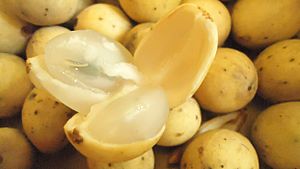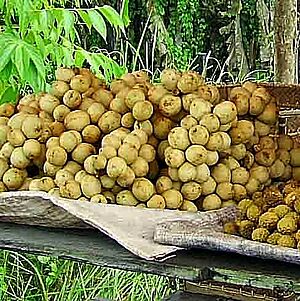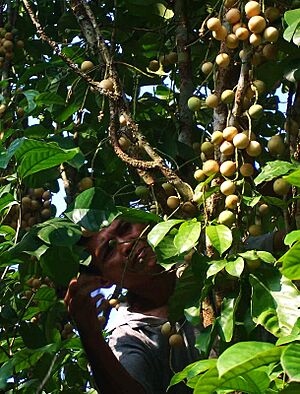Langsat facts for kids
Quick facts for kids Langsat |
|
|---|---|
 |
|
 |
|
| Lanzones in the Philippines | |
| Scientific classification | |
| Synonyms | |
|
List
|
The Lansium parasiticum is a tropical tree known for its delicious, edible fruits. You might know it as langsat, lanzones, or longkong. In some places, it's called duku or dokong. This tree belongs to the Mahogany family and grows naturally in Southeast Asia. Its sweet and sour fruit is a popular snack in many countries!
Contents
What Does the Langsat Tree Look Like?
The langsat tree is a medium-sized tree. It can grow up to 30 meters (about 100 feet) tall and its trunk can be as wide as 75 centimeters (about 30 inches). Trees that are 30 years old can reach 10 meters (about 33 feet) tall.
The trunk often grows in a unique, uneven way. Its roots can sometimes be seen above the ground. The bark of the tree is grayish and has light and dark spots. If you cut the bark, you'll see a thick, milky sap.
Leaves and Flowers
The leaves of the langsat tree are made up of several smaller leaflets, arranged like a feather. They are slightly hairy and grow in groups of 6 to 9. Each leaflet is long and oval-shaped, about 9 to 21 centimeters (3.5 to 8 inches) long. The top surface of the leaves is shiny.
The flowers grow in hanging clusters from the tree's large branches or even directly from the trunk. These clusters can be 10 to 30 centimeters (4 to 12 inches) long. The small, greenish-yellow flowers have both male and female parts.
The Delicious Fruit
The fruit of the langsat tree can be oval, egg-shaped, or round. It measures about 2 to 7 centimeters (0.8 to 2.8 inches) long. These fruits look a bit like small potatoes and grow in bunches, similar to grapes.
The skin of the fruit is thin and yellow, with a slightly fuzzy feel. When you peel it, the fruit inside looks like peeled garlic, with several white, see-through sections. Some of these sections contain a flat, bitter seed. The juicy, sweet flesh covers the seed and tastes like a mix of grape and grapefruit. It's known for being very tasty! The fruit is full of natural sugars like sucrose, fructose, and glucose. People usually prefer varieties with small or no seeds.
Different Types of Langsat Fruit
There are many different types, or cultivars, of Lansium parasiticum. They are generally divided into two main groups: duku and langsat. There are also types that are a mix of both.
Duku Varieties
The duku types usually have a large, thick tree crown with bright green leaves. Their fruit bunches are short and have fewer fruits. The individual fruits are large, round, and have a somewhat thick skin that doesn't release much sticky sap when you open it. The seeds are small, and the fruit has thick flesh with a sweet smell and a sweet or slightly sour taste.
Langsat Varieties
The langsat types typically have thinner trees with less dense crowns and dark green leaves. Their fruit bunches are longer, holding 15 to 25 large, egg-shaped fruits. The skin is thin and releases a white, sticky sap when opened. The flesh is watery and tastes both sweet and sour.
Kokosan Variety
One special type is called Lansium domesticum var. aquaeum, also known as kokosan in Indonesia. This variety has hairy leaves and tightly packed, dark yellow fruits. The fruits are small with thin skin and not much sap, making them a bit hard to peel. People often bite the fruit to make a hole and then suck out the flesh, or rub it until the skin breaks. Its seeds are quite large, and the flesh around them is thin and sour.
How Langsat Trees Reproduce
Langsat trees can reproduce in several ways. The seeds of the langsat fruit can grow into new trees. However, it can take a long time, sometimes 12 to 25 years, for a new tree grown from a seed to start producing fruit. The amount of fruit a tree produces can also change a lot from year to year. For example, one group of trees in Costa Rica produced very different amounts of fruit each year.
Another way to grow new trees is through a method called air layering. This involves encouraging roots to grow on a branch while it's still attached to the parent tree. While this method can produce fruit-bearing trees in about two years, these new trees might not be as strong or survive as well.
The third common way is grafting. This is when parts of two different plants are joined together to grow as one. Grafted trees will have the same traits as the parent tree and can start producing fruit in 5 to 6 years. These trees are usually stronger than those grown by air layering.
Where Langsat Trees Grow Best
Langsat trees grow very well in mixed forests where different types of plants are grown together. The duku type, especially, likes damp, shady places. It can be grown alongside other fruit trees like durian and petai, as well as trees grown for wood.
These trees thrive in areas from lowlands up to 600 meters (about 2,000 feet) above sea level. They need a good amount of rain, usually between 1500 to 2500 millimeters (60 to 100 inches) per year. They prefer slightly acidic soil that drains well and is rich in decaying plant matter. The langsat variety is tougher and can handle drier seasons if it has some shade and water. However, these trees cannot survive floods.
Langsat trees usually produce fruit once a year. The exact time can vary, but they generally bloom after the rainy season begins, and the fruits are ready about four months later.
Where Are Langsat Trees Found?
The langsat tree is native to Southeast Asia. You can find it naturally in countries like Peninsular Thailand, Peninsular Malaysia, Java, Sumatra, Borneo, the Philippines (including Luzon and Mindanao), Sulawesi, the Maluku Islands, and Western New Guinea.
It has also been brought to other places around the world, including Laos, Cambodia, Myanmar, Micronesia, Hawaii, Sri Lanka, India, and parts of the Caribbean like Trinidad and Tobago.
The tree is grown commercially for its fruit in Thailand, Cambodia, Vietnam, India, Malaysia, and the Philippines. It also grows well in the wetter parts of Costa Rica, where it was introduced many years ago.
How People Use Langsat
Langsat trees are mainly grown for their delicious fruit, which people love to eat fresh. The fruit can also be preserved in syrup. The wood from the tree is hard, thick, and strong, making it useful for building rural houses.
Some parts of the langsat plant are used in traditional medicine. The bitter seeds can be crushed and mixed with water to help treat worms and ulcers. The bark is used to treat problems like dysentery and malaria. Powdered bark can even be used for scorpion stings. The fruit's skin is used to treat diarrhea, and in the Philippines, dried skin is burned to keep mosquitoes away. The skin, especially from the langsat variety, can also be dried and burned as incense.
The biggest producers of langsat are Indonesia, Thailand, the Philippines, and Malaysia. Most of the fruit is eaten within these countries, but some is exported to places like Singapore, Hong Kong, and Kuwait.
See also
 In Spanish: Lanzón para niños
In Spanish: Lanzón para niños





